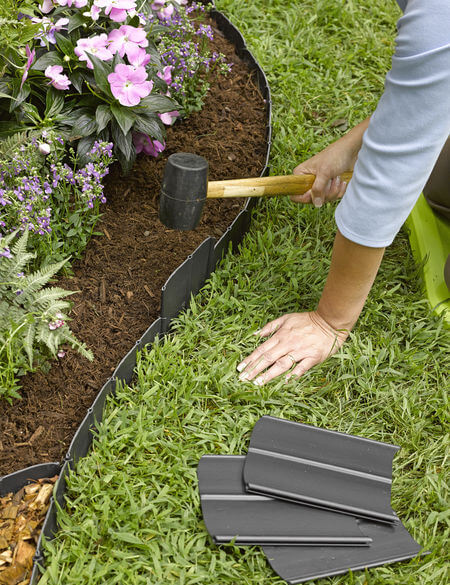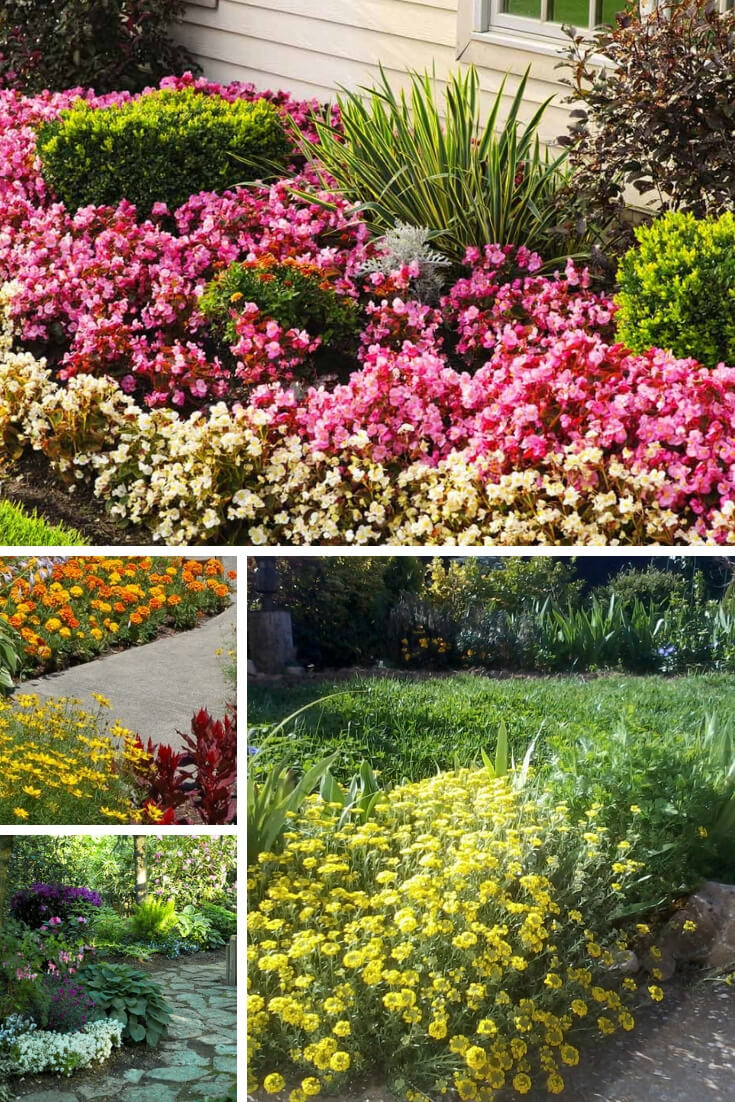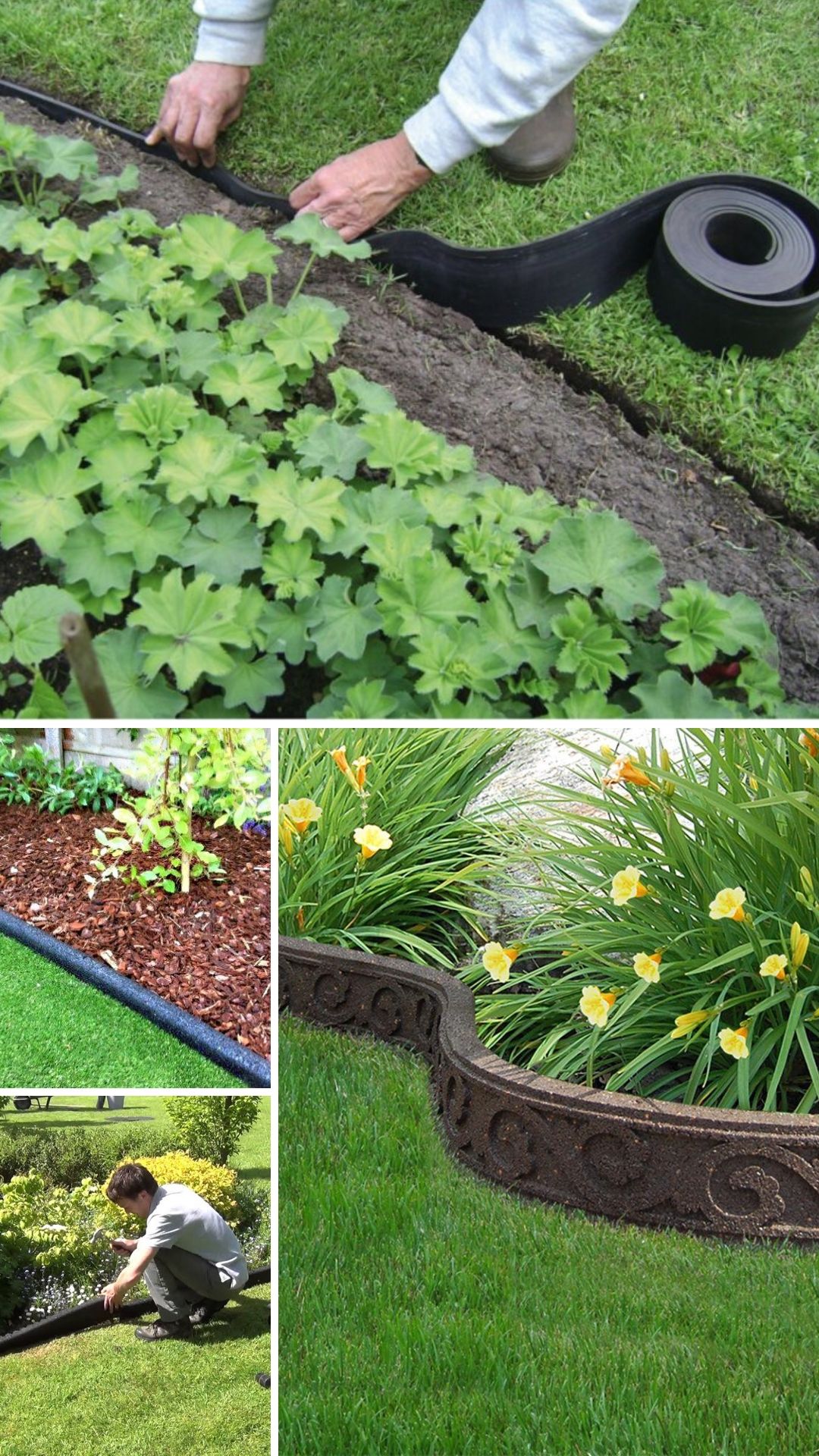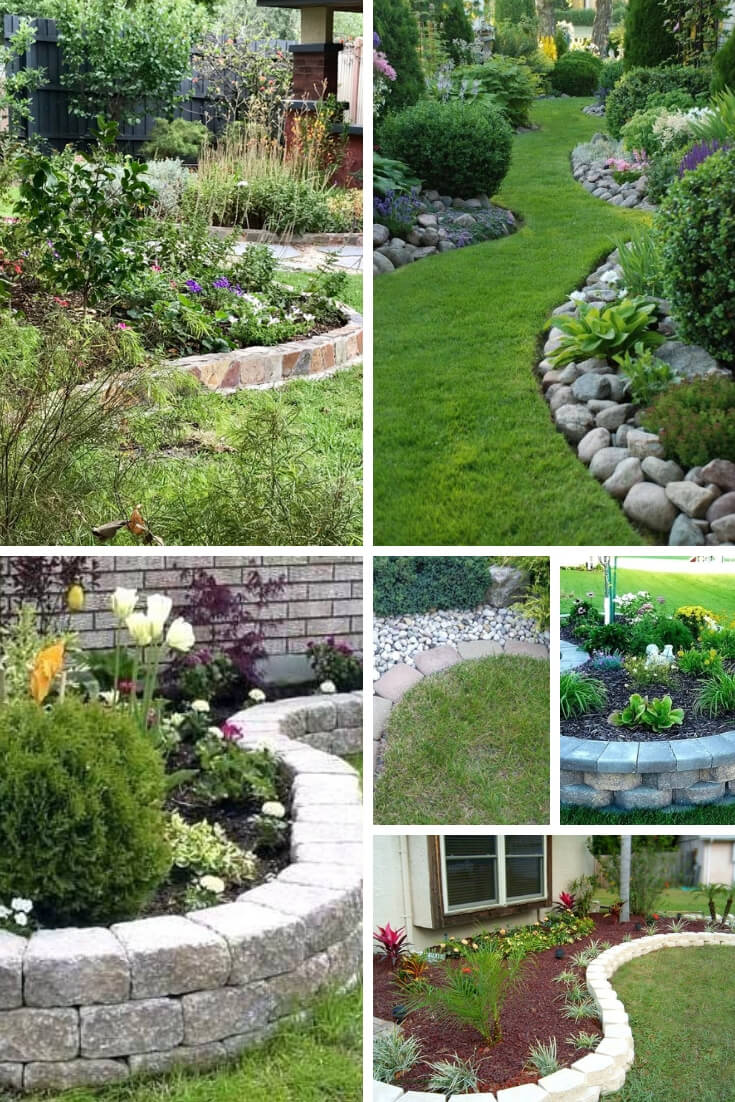Work on your lawn does not end with mowing, weeding, and raking. You should also not overlook the edges. Even with a perfectly cropped lawn, it will still look shabby without well-defined edges. Garden edging ideas provide functional and aesthetic functions to your garden.
From a practical and functional standpoint, garden edging helps in these aspects:
- Divides lawns and garden beds.
- Prevents mulch or soil in garden beds from getting into the lawn when you water or when it rains.
- Helps keep grass from crawling into the garden areas.
- Guard pathways made of soft and loose materials.
- Provides a clean line for trimming and moving.
- Creates a strong base for lawn mower wheels.
- Prevents lawn mower from damaging your plants.
From the aesthetic standpoint, garden edging can add to the curve appeal of your home:
- Clearly defines walkways and driveways.
- Accentuates the different areas in your lawn while keeping your overall garden design.
- Makes your garden look tidy and neat.
There are limitless materials and garden edging ideas. It is an inexpensive and practical way to keep your garden well-manicured adding to the value of your property.
Table of Contents

What can I use for garden edging?
Edging your lawn creates clean and crisp lines to distinctly divide your garden beds and lawn. There are a huge collection of garden edges ideas you can think of to highlight an area in your lawn, create borders, and add texture to come up with an amazing landscape design. But before planning for garden edging, make sure you have proper gardening tools available with you.
There are a wide range of combinations and choices of materials you can use for edging.
- Concrete
- Stone
- Wood / Timber
- Brick
- Metal
- Tiles
- Logs
- Glass
- Plates
- Recyclable items
There are no hardcore rules in designing your garden and landscaping. Garden edging ideas you create comes down to the materials you use, your style and creativity, as well as your budget.
How do you edge a garden?

Edging is the finishing touch to your landscape design. Carving with the use of a long-handled edger tool or a sharp spade is the first step to edging. It may take some time to carve your lawn with the use of these tools but they create precise edges.
A clear mark on the ground allows you to come up with a well-defined edge that is easy to finish and maintain. Mark the edge with spray paint or string to create an easy-to-follow line.
#1. Creating the Edge
Loosen the earth along your mark with a spade or edging tool. Use a shovel to remove loosened earth.
#2. Finishing the Edge
This will depend on the look you are trying to achieve. Using mulch to finish the edge makes it easy to maintain. Seek the help of a professional landscaper if you are not sure on how to finish the edge.
#3. Maintaining the Edge
Maintain the edge by weeding and cutting grass around your flower, vegetable and garden bed edges. Maintain the edge at least one a week. You will need a professional if you plan to do it only at least two times a season.
You need to be consistent in maintaining your lawn without overdoing it.
How do I separate the grass from the flower beds?
Garden edging ideas create clean and clear lines that separate grass from the flower beds. Garden edging is a well-defined border and bed is one of the qualities of an appealing landscape. Edging materials you can use are dependent on your choice and what will match your landscape design.
Edging serves as a physical barrier to keep your lawn from intruding into your flower, vegetable, and shrub beds. It also gives weeds a difficult time to cross over to your beds.
Landscape Edging
Landscape edging constructs the framework of your garden. Garden Edging may be pretty costly, and definitely so if you are going to employ bricks to edge your lawn.
You’ve made the choice of sod over seed for your lawn. It looks amazing and you want a beautiful garden edge to complete the look.
But one need not worry, since there are a lot of inexpensive ways to edge a garden. If you are creative, keep tab of the products on sale at a low price and you are ready to install it on your own, then you can bring down the cost. Here are some of the most amazing inexpensive ways to change the way your garden would look.
#1. Rock Edging
You can find rocks for free! They are present at construction sites, woods, roads – all lying around to be picked up. Rocks are one of the most important and log lasting part of garden edging and you would do good to pick up more than required.



#2. Wood Edging
You can create limitless garden edging ideas with wood as it is an easy to handle edging material.
- Create a border with balance beam logs that can provide your garden with charm and warmth while functioning as a natural obstacle course for kids.
- Create log lamps and deck them with glow in the dark or regular lighting features.
- Create an edge border designed as a picket fence.
- Create raised planting beds with wooden block panels which can double as a wooden border.
Treat wood with preservatives to prevent it from rotting.

Any kind of wood is good enough for edging your garden, but Landscape timbers are probably the best ones to use. In fact these are the best if you have straight edges, because in a curved garden it is very difficult to line with wood.
#3. Trench Edging



For trench edging all you need is good shoveling skills. This is the first task you need to do – dig a trench around your garden and use any of the materials like wood, metal, stone, rocks to edge.
#4. Plastic Edging

This is one of the most inexpensive but long lasting edging techniques in the history of garden edging.
You can get good quality home improvement plastics from stores. But before you install the plastic in the soil, you would do better to dig a trench and then place the plastic firmly with watered down mulch. Be careful not to mow down your plastic with the lawn mower!
#5. Edging with Plants

Let us try out the natural way to edge your garden! Yes, plants provide one of the best and more beautiful edging than rocks, plastics, metal or stones. If you have a low ground cover with a bush, covering the garden edge you are well off. You can even choose your color by the plant you wish to grow.
These landscaping ideas can add value to any home. It would make your home look more beautiful from outside. Proper care to edge your lawn will keep unwanted weed and grass out of your garden. You can always find the best methods of edging which suits your garden and home needs.
Vegetable garden edging ideas

Vegetable gardens create a vibrant atmosphere for your home because they help circulate cleaner air. Edging your vegetable garden not only makes it look eye-catching and attractive, it makes maintaining it less strenuous.
Installing edges and borders from practically any material available when designing your garden allows for better growth of your vegetables. Use your imagination and creativity. You can do anything as long as you distinctly separate your vegetable garden from your lawn for easy maintenance and aesthetic value.
Source: gardening-forum,
Lawn Edging Ideas
Lawn edging ideas can range from simple to bold designs. The main purpose of edging your lawn is to create borders or to separate different functional spaces within your lawn. Lawn edging also allows for easy maintenance.
Lawn edging is one of the best ways to control weed along the walkways and to make an attractive lawn. This saves a lot of time spent on mowing and weeding. Here are the life changing tips for lawn edging:
#1. Living Edge

Usage of garden cover plants like bushes and shrubs is a very innovative idea. Using a mixture of different plants for myriad colors and leaves would make it an amazing edge worth looking at.
The species you choose should by far have the same water, soil and sun requirements so that when you do maintenance, they can withstand the conditions.
#2. Natural or Recycled Edging

Using natural stones and pebbles to edge your lawn is inexpensive and long lasting. This will look so natural that people will hardly notice the artificiality.
Plastic recycling or reusable rubber tires, and using them for garden edging is a wonderful way to reduce non-bio degradable material. These materials are flexible and can be made to whatever shape required.
Since they do not wear away easily, once they are installed they can last for quite long time. So when you are installing them make sure your garden’s dimensions won’t change in the long run.
Your choice of edging material and style depends on your budget, and what appeals to your senses. You can get a lot of tips and tricks in the internet, but the ones shared in this article are the standard procedure and they are time tested.
#3. Rubber garden edging ideas

Recycled rubber looks pretty much like mulch and can be used to create borders in your lawn. It is a long-lasting material that keeps weeds and grass from penetrating onto your lawn. It also allows you to run your mower right along the border thus eliminating the need for trimming.
- Use it between grass and stone and it can replace mulch.
- Use it as a barrier between a rock wall and your lawn.
It also allows you to run your mower right along the border thus eliminating the need for trimming.
Cinder block garden edging ideas

Cinder block garden edging ideas allow you to deviate from the most common wood and stone edging style. Cinder blocks are characterized by the geometric edge they create between your garden beds and driveway. They are easy to construct and install and are low in maintenance.
- Turn cinder blocks into several mini planters for more space to grow plants.
- Paint cinder blocks to complement other features in your garden.
- Install cinder blocks in a curved position for a more interesting flower and vegetable garden.
Cinder blocks are inexpensive garden edging materials. They are heavy and solid allowing them to resist weeds.
Grass Edging Ideas
At one time or another you must have been irritated and have asked how to keep the grass out of your garden. Fret no more, since I am going to share the secrets with you.
#1. Wood and Brick Edging
As an edging material, brick creates the most polished and classic look. The choice of bricks and installation process create striking looks for your border.
You can use a single or a combination of brick shades for your border. You can use red brick or get a little bit bold and creative and use white, pink, tan, brown and gray bricks. Limit your color palette though so your border does not look too busy.
- Alternate different brick colors to emphasize your garden bed.
- Diagonally lay bricks combined with another landscaping material.
- Interlock stone bricks to coordinate with other stone materials.
- Lay bricks horizontally along your border.
- Lay bricks vertically to add height for more presence.
- Angle the bricks to create an eye-catching rough edge.
- Lay bricks alternately in horizontal and angled positions.
- Use recycled bricks to create a rustic look.
Easy installation is one of the major benefits of using bricks as an edging material. Once you are done digging the trench, you are done with the hard work.

Though wood and brick are one of the best techniques to use for protecting your garden from a grass attack, it would last you for three to five years. So you can redesign your garden, and give your garden the change look.
#2. Plastic and Metal Edging
Metal borders are strong and elegant making them a practical and clean-cut option to keep your plants and other lawn materials in place.
- Create borders with metals in straight lines.
- Use metal edging to create geometric gardens.
- Use metal borders to keep gravel and stone in place.
- Create a border in black metal along bluestone pavers.
- Create raised beds with river rocks and metal edging.
Metal landscape borders are typically made of aluminum and steel materials. It may be thin but it prevents ground movement, erosion, and can hold up to car tires on gravel driveways.

Before using plastic or metal to edge the lawn, you should dig a trench at least half feet below the ground, and then install these materials firmly.
This will keep the grass roots from sprouting in your garden. Also to keep the grass to cross over and spread you should keep a substantial height above the ground.
#3. Concrete and Pavers Edging
If you want a lasting and inexpensive way to edge your lawn, concrete is your best option. It is simple and easy to install concrete borders in your lawn. Concrete is also a versatile material that can match any landscape design.
You can create any shape with a special concrete mixture. You can dig a trench and simply pour the concrete mixture or build a mold in your desired shape.


Concrete and pavers give you the ultimate way to garden edging. This is the most permanent method and can last for ages. Though it involves a substantial cost upfront, it can prevent any kind of grass to spread in your garden.
#4. Steel garden edging ideas

Steel is a long-lasting, tidy, simple, and easy to install material for garden edging. It is versatile as you can bend it in any shape allowing it to be used with all types of soil. It can also be mown over.
- Use cast-off steel piping to line your garden edge in straight or curved lines.
- Fill up steel pipes with soil or gravel to create a rock garden edge or raised beds.
- Create a stunning effect by arranging recycled steel wheels along your flower or vegetable bed edge.
You can either ruse scrap steel or purchase ready-to-use flexible steel edging materials for your garden.
#5. Aluminum garden edging ideas

Using aluminum creates orderly and neat garden edges. It will not crack, rust or fade. Can be painted and shaped into curves to create amazing and creative garden borders.
- Fill an aluminum frame with rocks and place wooden seats atop to create not only an amazing edge border but additional seats in your garden.
- Create a design in any shape to edge your garden beds anyway you want.
Aluminum garden edges can also be used to separate lawns from driveways and pavers.
No Dig Garden Edging
No dig garden edging materials are the best store bought and do-it-yourself to create defined borders for your lawn. They are easy to install because they are simply laid on the ground and not buried.
- Choose rocks of almost the same sizes and line them along your garden edge.
- Create a curved shape or whatever your imagination dictates.
- Lay plain or painted bricks in any outline you desire.
- Collect recyclable materials such as bottles, old pots, old plates or tires etc… and creatively arrange them to create a fence along the garden edge.
Coming up with garden edging ideas using materials you can simply lay on top of the ground is a fun and exciting way to design your garden edges.

Bamboo garden edging ideas

Bamboo is a cool material that can create numerous garden edging ideas.
- Fill bamboo with soil to create added raised flower or vegetable beds and line along your garden edge.
- Create a fence in any height you desire or in varying heights to create a unique design.
- Cut bamboo into smaller sizes and alternately line the garden edge in an interlocking manner.
Bamboo is a gorgeous material that is tougher than many timbers. It can last for many years in the ground even without any chemical treatment.
Stone Garden Edging
Stone is beautiful and indestructible making it an ideal garden edging material for high-trafficked gardens.
- Use big stones with almost similar sizes to create a walled effect.
- Dig a trench edge and fill it up with stones and rocks of almost similar sizes.
- Choose from the many colors of river rocks to fill up a trench in your garden bed which is beside a path or patio.
- Collect rocks around your garden, ask neighbors for excess rocks or buy decorative rocks and place along the garden edge.
- Use cobblestones to create a walkway or pathway that doubles as your garden bed edge.
- .Choose from the many stone shapes and sizes to create raised stone edging and make a featureless or flat lawn look more interesting.
- Be far more creative and install a mosaic-typed stone set along a concrete pathway.
- Use stones with contrasting textures and with complimentary colors to edge a flower bed.
A combination of plastic and stones as well as decorative glass are also great ornamental garden edging ideas. A simple and plain rock border can also look beautiful in your lawn.


Using stone garden edging is cheap, and easy to install. This gives your garden a natural country feel. You can even buy different colored stones to make a beautiful garden which would look elegant. In fact to reduce costs further, you can install the set-up yourself without engaging a professional.
The first thing which you must do is to dig a trench deep enough for a perfect installation. You should create the trench around the garden and along the pathway boundaries. A narrow trench will do since this will make the garden look clean and beautiful.
Placing the stones is an art which one can learn from many an internet video links. You can mix and match the colors of the stones to get a decorative look and feel. Next you should position the stones firmly so that they do not come out later.
For this you need to pack the region around the stones with sufficient soil and then water the region so that it holds the stones securely. Next to make it certain that it remains fixed, you should pat them down with your hand or feet. That was easy isn’t it?
A gardener with interest on plants would want to grow his plants in an environment which is free of weeds and grass. However, he would also be interested to have a beautiful garden which will add an aesthetic value to his home. Stone garden edging adds this beauty and gives a wonderful sense of achievement.
Flagstone garden edging ideas
Although flagstones are often used for patios and walkways, they are also good edging materials for garden beds.
- Securely stack some flagstones in different colors and thicknesses to create a rustic touch or a country-styled garden.
- Lay flagstones flat or horizontally.
- Lay a set stone along the edges of a flagstone edge for added height and a raised curb.
When using flagstones as an edging material, you need to dig a trench and install them halfway through the ground.
Conclusion
There are limitless garden edging ideas you can come up with using varying materials. Garden edging not only protects your garden beds but adds to the beauty of your garden.






